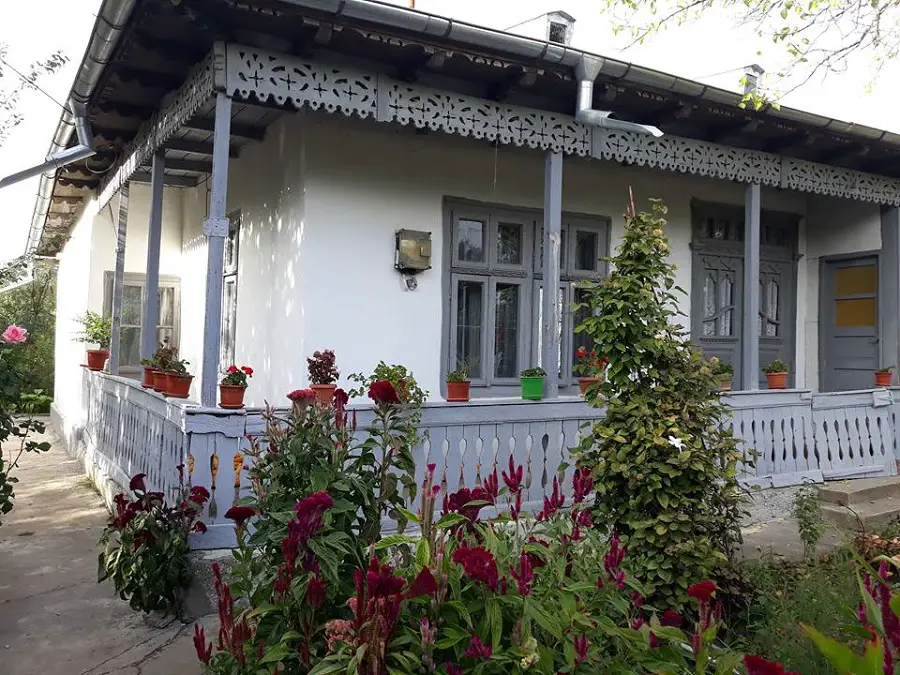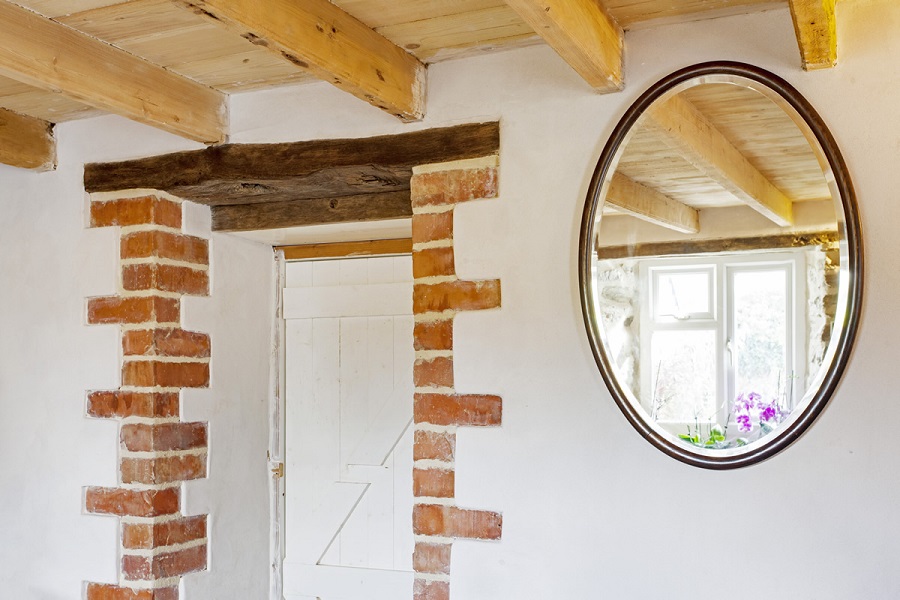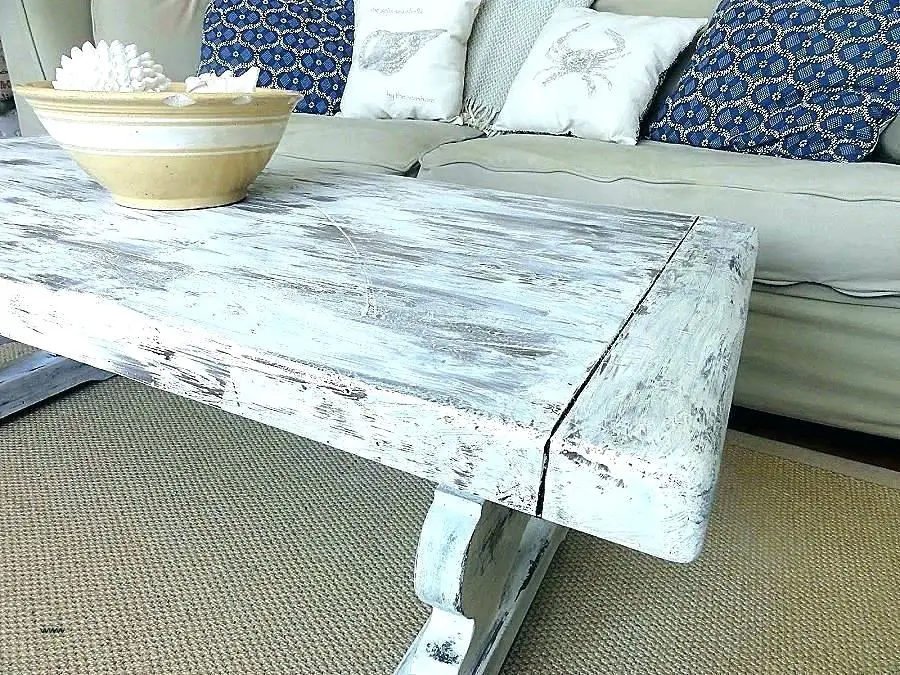Lime is a material with a lot of qualities, unfairly overlooked. Although there was a time when no one could conceive of general cleanliness without lime, it is now being replaced by other materials and few would consider the lime option if they had to paint. Even more so if they had to finish wood. And yet such primers and paints are still used for walls, ceilings or floors to achieve a healthy environment, very suitable for children, people with allergies or respiratory conditions. Let's take a closer look at lime.
Once upon a...
Once upon a time there was a village in the Bărăgan where in the spring all the houses were shaken, swept and painted, inside and out, to be clean, tidy and to smell nice for Easter. Where the trees were cleaned of the dry leaves, the trunks were varnished to within 1 meter of the ground, and the dry leaves from the trees and the garden were gathered in the middle of the garden where a large, purifying fire was built. And it smelled nice, spring and clean!
Fortunately, there was not just one village in the Bărăgan but many villages here and elsewhere. Unfortunately, I don't know how many of these villages are still able to do such activities and how many still enjoy the fresh and clean smell of freshly painted walls.
Our elders knew, without chemistry or biology lessons, that lime is a natural antiseptic, that fungus and molds do not grow on the walls of the house, and that people in the house are less likely to get "chest" (respiratory problems). They also knew that the varnished trees would not be attacked by insects. But it began to bother us that the lime on the wall sometimes got on our clothes, that it was harder to work with, and we invented new products that were easier to use, stronger, but not always as healthy. Lime slowly fell out of our idea of cleanliness and we forgot how many qualities it has. I think it's not too late to remind ourselves of the qualities of lime and as far as possible, start using it again.

What is lime and how to use it
Lime can be considered the most versatile building material of the civilized world. The Egyptians, Mayans, Greeks, Romans and Romans used it as a binder in mortars, plasters and paints, and their constructions stood the test of time. If at first it was more of a mixing material, since the middle of the last millennium (1500s) it has also been used for interior and exterior wall finishes. It was used by Leonardo da Vinci, Michelangelo and Raphael, and has been mentioned in works of the time.
Heavy use continued until after the Second World War, when it was overshadowed by the advent of cement, a harder material that hardened much faster than lime. But lime is now making a comeback thanks to its properties.
Wall lime, after drying, is the same as the natural rock from which the finishing material - calcium carbonate CaCO3. The process of obtaining and using lime is comparable to a hoop. Calcium carbonate is a naturally occurring rock formed millions of years ago from the shells and shells of marine life. It is also called limestone. To make it usable, it is burned at temperatures of 800ºC and converted into calcium oxide CaO - unburned lime, a substance that is unstable in the presence of water.
In reaction with water, the unburned lime 'quenches', turning into calcium hydroxide Ca(OH)2 - the quenched lime. The reaction is very violent and gives off a lot of heat, which can be quite dangerous if the person slaking the lime is inexperienced. The slaked lime is used for plastering and for making whitewash, which is applied as a final finishing coat. Once applied, the lime (calcium hydroxide) slowly reacts with the carbon dioxide in the air and reverts to its original form of calcium carbonate CaCO3, the hard, solid layer that remains on the wall. And so the circle closes. Lime is considered to be a natural material with zero carbon dioxide balance precisely because what is released during its production is consumed during curing (drying).

Benefits of using whitewash to finish the walls of your home
Besides zero carbon dioxide balanceLime also has other advantages. It has alkaline pH which prevents fungus and mold from growing and the air in the painted rooms is very healthy. It is recommended for wall coverings in children's rooms, rooms of people with respiratory problems or allergies.
Veined walls allow water vapor to pass through acting as a permeable barrier. This prevents moisture from being trapped inside the wall, which prevents damage to the building (masonry or structural timber).
Mix well with clay, plaster and cement being a very good binder for these materials.
It is white with a slight natural sheen. Thanks to this bright color it gives a clean feeling. But it can be mixed with pigments for coloring if you want walls other than white.
And last but not least, lime does not burn. It is a flame retardant material protecting the substrate on which it is deposited.
The weak point is that when drying, the lime shrinks and cracks may appear. This is why it should be applied in thin layers, with the next layer applied only after the previous one has completely dried. This results in a longer working time compared to other materials.

Modern natural products with the same good qualities but without application or cracking problems
The use of natural products when building and finishing homes is a growing trend of late. Lime is also being targeted, but its use no longer involves extinguishing it as it used to. Lime is ready to use - like modern paints - or in powdered form that is mixed with a set amount of water to make tough, healthy plasters.
Naturalpaint is one of a number of companies aiming to make a return to healthy natural products. Besides natural insulation for wood and brick houses or waxes and natural oils for wood, the company's portfolio also includes lime. Whether as a putty, plaster or paint, lime retains all the qualities of the lime used in the past, while adding new ones through the manufacturing process. For example, the addition of cellulose - a natural binder - makes the plaster much more firmly fixed and prevents it from clinging easily to clothes when leaning against the wall.
The antiseptic properties of lime products from Naturalpaint are also confirmed by Germany's Oko-test magazine, which focuses on environmental friendliness. This magazine tests existing products on the market and gives them ratings. In the case of lime-based paint, the rating was Sehr Gut (very good).
So there's the possibility of going back to the lime lime without all the work and risks that were involved in the past.
How lime looks on wood. Limewash finish
The limewash finish for wood also comes from the past. When they were plastering, grandparents didn't just cover the clay walls, they also covered the ceiling or the floorboards made from planks of gelled planks. Sometimes even the furniture. They knew this from the trees in the garden. Over time, the lime melted and the wood underneath began to show through. This is what the finish looked like limewash.
Some consider it to be identical to whitewashothers see it differently. From my point of view it is different, whitewash being the softer, less rustic, more elegant version. Limewash retains the roughness of the lime and has a less elaborate, rougher look.
The look can be achieved using lime paints or other materials that are not very fine-grained. After applying the material and processing to the desired effect, the finish is fixed with clear wax. This will also protect it and make it easier to maintain.
White wax can also be used to reproduce the limewash effect. The content of white pigment or calcium carbonate in the wax must be high for the coating to be very good. It is very good for marking large pores in wood. For a good result, apply in excess, then wipe off the excess with a cloth.

Lime is a material whose return to our lives has only beneficial effects. Used to paint walls, it protects them from fungi and mold, lets them "breathe" by allowing moisture to pass through and restoring balance, improves the air in the room, making it easier to breathe for those with respiratory problems or allergies. And the wood is protected from insects at the "price" of a very interesting finish - limewash.
Thinking of painting and undecided about wall paints? Varul may be the solution!


































Correct is CaCO3
Thank you! Corrected.
Hello, what can I use to clean and disinfect a wooden bridge in my grandparents' house? (approx. year 1970).
Hello!
I don't understand exactly to what level this cleaning is. If it's just dust, washing with soap and water is sufficient. After washing, all wooden objects and boards (painted or not) should be wiped well with a dry cloth and left to shake.
If you want to remove old layers of paint, you can use thinner, turpentine or soda (there is a pickling version at Naturalpaint).
For more information see the link below.
All the best!
https://revistadinlemn.ro/2017/06/13/cum-sa-aduci-la-viata-cufarul-vechi-din-pod/
Hi, I built a pine house about 4 years ago, the house is not insulated so far because the wood was kinda green when I built it and I let it dry out and I keep hearing rumors on the internet that decay can destroy wood, could it be wood decay?
Hello!
If the wood has been infested, under the right temperature and humidity conditions, decay develops and the strength of the wood can decrease because of the galleries they make in the wood. If small holes have not appeared in the wood or flying insects appear to be coming out of the wood during this time, the wood has not been infested. However, it is recommended that the wood be treated with a preventive anti-cavity treatment before the thermal insulation is applied. If there are holes, then there are curry larvae in the wood and an anticari treatment is mandatory.
Find more information about curries in the articles below.
https://revistadinlemn.ro/2017/09/08/despre-cari-motivul-aparitiei-ciclul-de-viata-preventie-tratamente/
https://revistadinlemn.ro/2018/08/23/tratamente-naturale-impotriva-carilor/
https://revistadinlemn.ro/2020/07/30/cum-scapi-de-cari-si-alti-daunatori-ai-lemnului-solutii-anticarii-lemn/
https://revistadinlemn.ro/2020/08/27/tratament-preventiv-impotriva-ciupercilor-mucegaiului-si-a-insectelor-care-ataca-lemnul/